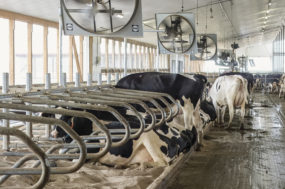It’s no secret dairies use a lot of electricity and, up to this point, dairymen have simply had to bite the bullet and pay the fees electrical companies charge in order to keep the milk flowing.
Terry Anderson believes he can change the way dairymen power their dairies as well as saving money when working their fields. He has several solutions, all powered through technology from the Rural Energy Corporation.
Terry Anderson is the inventor behind the Rural Energy Corporation and the mind behind multiple inventions and patents. You might say he is a man who thinks outside the box, well outside the box.
He is one guy who sees the way things are and wonders why – and in the process of answering that question can come up with a workable solution that makes life easier for everyone around him.
One of his ideas, an ammonia fuel cell, isn’t a new idea but simply a new way of doing something that has been done for many years – but not to the scale he takes it.
“I was in Europe and started asking questions about how farmers brought their crops in during World War II. I was told they used horses but there wasn’t a conceivable way enough horses could have been bred, raised and trained in the short span of time given,” he says. “The answer was that they used ammonia for tractor fuel.”
He says that ammonia can be created from wind using an inexpensive method, and it just makes more sense.
“Dairies use a lot of electricity, and wind can replace that electricity by producing fuel and fertilizer,” Anderson says. “One or more of these are utilized in every operation.”
Anderson envisions an operation that produces its own energy using ammonia and storing the excess until needed. He grew up on a farm in Minnesota and was keenly aware of how labor-intensive farming can be, and labor costs are some of the highest fees paid out. He figured if he could cut some of those costs, maybe more family farmers could stay in business.
“With ammonia, there isn’t any wheeling back to the utility company,” he says. “You can use a small standby generator and also store the excess ammonia in tanks for later use.”
To him, it just makes more sense to operate outside the grid. “Why pay a service cost when you aren’t receiving it?,” Anderson asks. “We use all of the energy that we produce so the utility company can take down the lines.”
He says the problem with the windmills in use today is that they were not designed to last 50 years. The initial layout might be more than a million dollars, and over 20 years there will be a half-million-dollar layout for repairs during that time. Using the Rural Energy Corporation’s wind turbine technology can reduce significantly the cost of farm fertilizer, fuel and electricity use up to 75 percent.
Another method of reducing costs is to convert existing tractor technology to driverless autonomous tractors that not only replace a farmer in his field but also replace the diesel fuel costs associated with the tractor’s operation using ammonia fuel. Using ammonia to fuel a farm instead will produce better fuel than gas or diesel, and it doesn’t produce any CO2.
When Anderson first proposed creating ammonia fuel cells, he was actually looking at diesel technology in use in tractors and farm equipment that is 80 years old that had not been substantially updated in all that time.
“Farmers today are ending up with a tractor that takes several weeks to repair – if it can be determined which part is needed and someone has the time to fix it,” he says.
“We are converting diesel engines to ammonia fuel cells, and we can build tractors for less than half what they are costing now, plus we can create our own ammonia for less than 75 percent of the cost farmers are paying for fertilizer now.”
His idea is to use radio-guided, self-propelled autonomic tractors that don’t use GPS but can farm the field while the farmer is doing something else. He says a man sitting in the cab of a tractor for 16 to 18 hours a day finds his mind going numb.
Kraig Schulz is the CEO of the Autonomous Tractor Corporation and works together with Anderson. He says the best thing about their autonomous tractors is that their technology puts the farmer back in control of his farming situation.
“Our tractors have no transmission, no differentials and no axle,” Schulz says. “You can take out the drive train in a conventional tractor and replace it with a diesel electric drive that is basically a generator. It is a lot less expensive than a regular tractor, more efficient and repairable by a farmer on his own farm, in his own field.”
In other words, it saves money up-front as well as in day-to-day operations. It just makes more sense.
“If we can put a self-propelled vehicle on Mars, why can’t we put one in a farmer’s field?” Anderson asks. “It’s a tragedy how many family farms shut down each year when, with a little applied technology, we could save them money.”
He says it just plain makes sense to him as an inventor that upgrades that should have been made and haven’t been are now being sought after by farmers thinking progressively.
“The progressive producer is interested in doing things economically. If an industry doesn’t re-invent itself every few years, someone is going to run them,” Anderson says.
“There is nothing manufactured and produced in China that couldn’t be produced right here in the U.S. for less. We have the technology to take back the jobs.”
Using the ammonia-fueled autonomous tractor will not only save wear and tear on the farmer but on the engines and transmissions that drive most tractors.
“My experience in more than 50 years of working with technology tells me I can make farming more affordable,” Anderson says. “Small molecules, like those in ammonia, are easier to break down at a lower heat. Carbon-based fuels take higher heats to break down and are harder on the engines.”
Artificially intelligent driverless agricultural equipment can help with the increasing farm labor shortage, a problem dairy farmers face daily in their fields. Someday robots may replace the dairymen inside the barn, but they can replace themselves in the field now with this technology.
The Rural Energy Corporation and the Autonomous Tractor Corporation believe they can help dairymen by reducing equipment costs up to 50 percent, reducing repair costs up to 75 percent and increasing the service life of their equipment by greater than 300 percent. Using new technology available in the world today, they believe the life of the dairyman will improve substantially.
“We believe that we have a huge impact on the farming industry,” Schulz says. “We are on the right track now; we just keep perfecting our system to help more people.” PD
PHOTO: This is the John Deere tractor after conversion to the new autonomous technology created by the Autonomous Tractor Corporation (ATC). Photo provided by Autonomous Tractor Corporation.
Becky Cook is a freelance writer from Iona, Idaho






